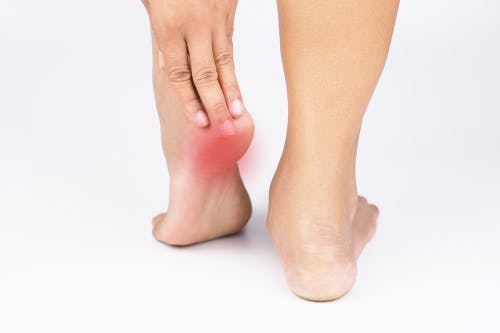Heel Pain

Heel Pain is one of the most common foot conditions we see at Foot Right Podiatry. It is a broad term, and there are many conditions that may lead to you having pain predominantly in your heel area. The most common heel condition we see is Plantar Fasciitis or “Heel Spurs”.
PLANTAR FASCIITIS
The plantar fascia is a strong fibrous material on the sole of your foot, running from the heel bone (calcaneus) to the metatarsal bones at the ball of your foot.
The main role of the plantar fascia is to hold up the arch of your foot. Due to the make up of the plantar fascia, its fibres can become inflamed, overused, torn or even ruptured.
People will present with plantar fasciitis at different stages of severity. Initially, you may feel as though you have a bruised heel, which stops you from doing all the activities you wish to or prevents you from wearing certain shoes. At Foot Right Podiatry, we find that most of our clients will ignore the problem at this stage, and hope that the pain will just go away.
As the condition progresses, you may feel that the heel area has become more uncomfortable. The area of discomfort can move from your heel to further into your arch. The pain will be apparent strongly when you first get out of bed in the morning, and can cause you to hobble for your first steps before the pain reduces or goes away completely.
At its most severe, plantar fasciitis will cause moderate to intense pain on the undersurface of your heel and arch throughout the day with very little relief. You will want to change your footwear regularly and will be always searching for a more comfortable shoe.
In some cases, you may have a tear or even a rupture of your plantar fascia. This is a serious condition and can require surgical intervention.
COMMON CAUSES OF PLANTAR FASCIITIS
- Non-supportive footwear
- Tight calf muscles
- Foot structure – high arches as well as flat feet can contribute to heel pain
- Sudden increase in activity levels – often associated with a get fit program!
- Increase in body weight
HEEL SPURS
“Heel spurs” is a term that people often use when presenting with heel pain.
A heel spur is a radiographical finding (what is seen on X-Ray) but in almost all cases it is not what is causing your pain. A heel spur can be found on X-Rays of people who do not suffer from heel pain and if you have had an X-Ray that shows a heel spur but do not have pain, you do not require treatment.
The spur that can be seen on the X-Ray is actually calcification of the plantar fascia at the point at which it joins into the calcaneus and is potentially a sign of stress on the plantar fascia.
If you believe you are suffering from a heel spur, we can help you correctly diagnose and manage your condition.
TREATMENT
At Foot Right Podiatry, we tailor treatment of your heel pain to your individual needs, but treatment may include massage, strapping, and an exercise program to get you better as quickly as possible. We will recommend footwear change if it is necessary, and you may need to alter your activity for the best results. Dry needling can also be used to address muscle tightness that has implications for your condition. In some cases, foot orthoses may be recommended if your recovery is slow, or if there are other underlying issues, which may be contributing to your heel pain.